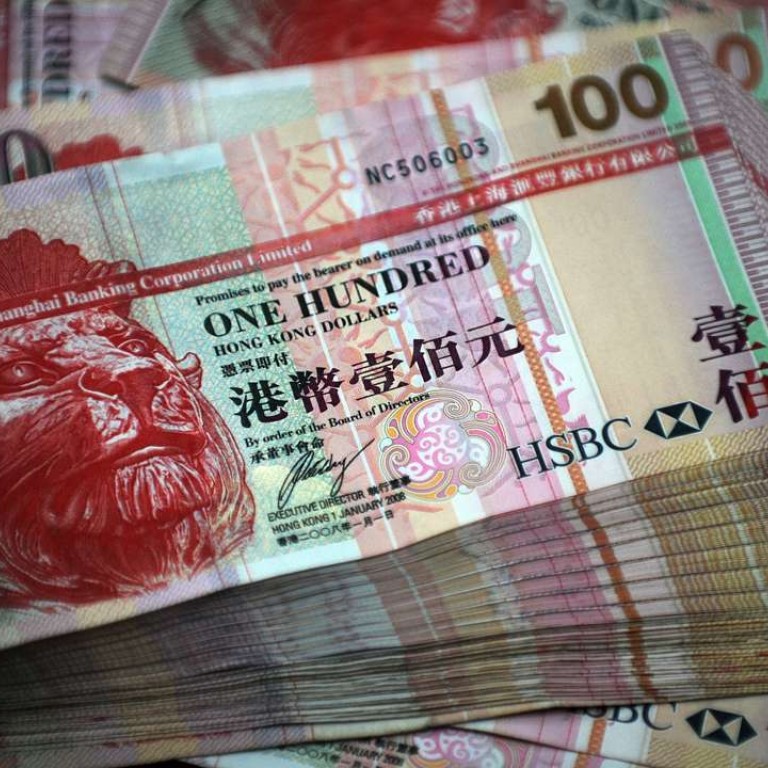
HK dollar to hit weakest level within its peg system to USD as Fed shrinks balance sheet
Bank of America Merrill Lynch suggests local currency will slip to 7.85 against the greenback, prompting intervention by the Hong Kong Monetary Authority
The planned reduction in the US Federal Reserve’s balance sheet will eventually lead the Hong Kong dollar to 7.85 against the greenback, to which it is pegged – the weak side of the allowed value range – and could spark speculative short-selling, prompting intervention by the Hong Kong Monetary Authority (HKMA), according to analysts at Bank of America Merrill Lynch (BofAML).
The HK dollar trades between 7.75 and 7.85 to the US dollar.
Such an intervention was needed after the Fed started its programme of quantitative easing in 2009, but the upcoming move is likely to be done in the opposite way.
“Although we believe this is entirely consistent with the currency board’s framework, we do not rule out the possibility of speculative pressures on the Hong Kong dollar,” BofAML analysts Ronald Man and Sylvia Sheng said in a latest research report.
“In this scenario, we recommend investors be patient and avoid any excessive moves as we believe the currency board is here to stay.”

Minutes from the Fed’s March meeting suggested it may start reducing the size of its US$4.5 trillion balance sheet “later this year”.
“Our US team expects the Federal Reserve’s balance sheet to reach steady state equilibrium between 2021 and 2022, with the balance sheet falling by between US$1.1 trillion and US$1.4 trillion,” Man and Sheng said.
As the Fed continues to tighten its monetary policy and the Hong Kong dollar’s interbank liquidity remains flush, the city’s currency is likely to eventually reach 7.85, amid capital outflows from Hong Kong, BofAML said in its note.
When the Hong Kong dollar reaches that weak end of the two-way convertibility range, the HKMA is likely to purchase Hong Kong dollars and sell US dollars, which would reduce interbank liquidity in Hong Kong, raise Hong Kong dollar rates, and reduce depreciation pressure on the city’s currency against the greenback.
We recommend investors be patient and avoid any excessive moves as we believe the currency board is here to stay
It’s important to recognise why there is so much interbank liquidity in Hong Kong in the first place.
“The primary reason is quantitative easing by the Fed since 2008, which has caused the Hong Kong dollar to strengthen significantly against the US dollar, reaching the strong side of the two way convertibility range at 7.75,” said the Bof AML analysts.
When that occurred, the HKMA bought US dollars and sold Hong Kong dollars to protect its currency board, at the strong end of the convertibility range.
Likewise, should the Hong Kong dollar eventually weaken to 7.85 due to monetary tightening in the US, the purchase of Hong Kong dollars and sales of the greenback by the HKMA will mirror what happened at the start of US quantitative easing.
“We strongly believe there are no fundamental reasons why investors should question the credibility of the currency board in this scenario,” they said.
Short-selling pressure on the Hong Kong dollar could possibly appear again, and potentially threaten the stability of the banking system which needs to handle any sharp increases in Hong Kong dollar rates.
Higher Hong Kong dollar rates could lead to increased household debt, especially mortgage repayments, lower incomes and put downward pressure on consumption.
However, the overall negative impact of higher interest rates on private consumption from the income channel would be limited, the investment bank added.
The HKMA can support Hong Kong dollar liquidity through two ways if excessive speculative pressure persists: allowing outstanding fund bills and notes to mature, and providing liquidity support through the discount window.
“It is unlikely for the HKMA to rush to remove excess interbank liquidity,” said the Bof AML note.
“We maintain our forecast for USD/HKD rate to to 7.8 by the year end.”

